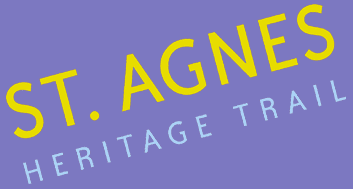
Walk 7 - Wheal Coates, Chapel Porth, Wheal Lawrence Valley and Goonvrea
The National Trust Car park at Wheal Coates is a good starting point for a walk that takes you from open heathland and cliffs at Wheal Coates, through the sheltered valley at Chapel Porth to Goonvrea, and so back to the car park along Beacon Drive.
The Car Park
Behind two of the banks which edge the car park are clay pits, evidence of the narrow band of granite which curls around the south-western side of the Beacon. Now the pits are overgrown by heather, gorse and willow but in the past clay was extracted for pottery making and for use in the mines. As you leave the car park past the donation box look to the right and you will see a single isolated stack; this is the earliest part of Wheal Coates mine, built around 1830. Near it is a sloping roofed cottage which was once the Count (Account) House for the mine.
The Car Park to Wheal Coates
 Follow the wide track from the car park to the main
buildings at Wheal Coates A. (This small section of
the walk is wheelchair friendly). In early summer the
heathland is purple with bell heather and dotted with
smaller patches of pink cross-leaved heath. These give
way in late summer to the mauve of ling and the gold of
dwarf gorse. On the right hand side of the track are
many pits and bumps, some of which are thought to be
relics of mediaeval surface mining.
Follow the wide track from the car park to the main
buildings at Wheal Coates A. (This small section of
the walk is wheelchair friendly). In early summer the
heathland is purple with bell heather and dotted with
smaller patches of pink cross-leaved heath. These give
way in late summer to the mauve of ling and the gold of
dwarf gorse. On the right hand side of the track are
many pits and bumps, some of which are thought to be
relics of mediaeval surface mining.
The Mine
 On the wall of the whim engine house at
Wheal Coates, the National Trust have
thoughtfully fixed an information board
which describes the original function of
the ruined mine buildings, built in the
quest for tin and copper. Now the
buildings, particularly the engine-house
and calciner stack, are used instead by
ravens and nesting jackdaws. Have a
look at how expertly the huge blocks
were laid one on top of another; the soft
colours of the rocks reflect the minerals -
particularly copper and iron - which
they contain. St Agnes Museum has the
bell from Wheal Coates which signalled
the ends of the shifts, and also other
information on the mine, including the
amounts of tin and copper it produced, and the rates of pay for the men who worked there B.
On the wall of the whim engine house at
Wheal Coates, the National Trust have
thoughtfully fixed an information board
which describes the original function of
the ruined mine buildings, built in the
quest for tin and copper. Now the
buildings, particularly the engine-house
and calciner stack, are used instead by
ravens and nesting jackdaws. Have a
look at how expertly the huge blocks
were laid one on top of another; the soft
colours of the rocks reflect the minerals -
particularly copper and iron - which
they contain. St Agnes Museum has the
bell from Wheal Coates which signalled
the ends of the shifts, and also other
information on the mine, including the
amounts of tin and copper it produced, and the rates of pay for the men who worked there B.
 Walk 1 - St.Agnes Village Trail
Walk 1 - St.Agnes Village Trail Walk 2 - St Agnes Beacon
Walk 2 - St Agnes Beacon Walk 3 - Porthtowan, Banns Vale, Mount Hawke and Chapel Porth
Walk 3 - Porthtowan, Banns Vale, Mount Hawke and Chapel Porth Walk 4 - Wheal Rose, The Poldice Plateway and Mawla
Walk 4 - Wheal Rose, The Poldice Plateway and Mawla Walk 5 - Mount Hawke
Walk 5 - Mount Hawke Walk 6 - Mithian
Walk 6 - Mithian Walk 7 - Wheal Coates, Chapel Porth, Wheal Lawrence Valley and Goonvrea
Walk 7 - Wheal Coates, Chapel Porth, Wheal Lawrence Valley and Goonvrea Walk 8 - Water Lane, Wheal Butson and Jericho Valley
Walk 8 - Water Lane, Wheal Butson and Jericho Valley Walk 9 - Jericho Valley and Cross Coombe
Walk 9 - Jericho Valley and Cross Coombe Walk 10 - Blackwater
Walk 10 - Blackwater
